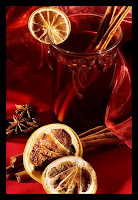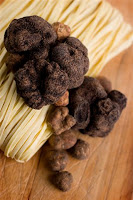 The first time I ever heard the term mulled wine, Clarence, the angel in Capra's "It's a Wonderful Life" ordered it while sitting in a bar with George Baily. I was about 7 or 8 years old. Mulled wine, hmmmm it's fall, winters coming, let's take a look see.
The first time I ever heard the term mulled wine, Clarence, the angel in Capra's "It's a Wonderful Life" ordered it while sitting in a bar with George Baily. I was about 7 or 8 years old. Mulled wine, hmmmm it's fall, winters coming, let's take a look see. In medieval times, sanitation was poor and many believed it was far healthier to drink mulled wine than risk drinking water. There is some truth to the health benefits, as drinking wine in moderation has been linked to reducing the risk of suffering from heart disease, diabetes and dementia. Lemon and orange both contain vitamin C which acts as an antioxidant.
Mulled simply means heated and spiced. So you can have mulled wine, mulled cider, mulled mead, etc. No one knows the true history of mulled wine, but there was medieval mention of Ypocras or Hipocris named after the physician Hippocrates. These drinks were thought to be healthy and served as tonics in the Roman Empire. Fast forward to around 1500 and British cookbooks speak of mulling Clarrey. This was Bordeaux wine infused with honey, cinnamon and cardamom. Those Victorian English enjoyed their mulled wine, and even served a version of it, called Negus, at children’s birthday parties. If you boil the wine when making it, you can burn off the alcohol and I’m sure that’s what the Victorian parents did before serving it.
 Most likely, the drink got its origins from wine sellers who found themselves with some spoiled product. These innovative manufacturers heated their sour merchandise, flavored it with honey and spices and a new drink was born.
Most likely, the drink got its origins from wine sellers who found themselves with some spoiled product. These innovative manufacturers heated their sour merchandise, flavored it with honey and spices and a new drink was born.No matter what European country you find yourself in around the holidays; you are bound to come across a local version of their mulled wine. The Swedes serve glögg, while the Germans enjoy gluhwein. The French sip vin chaud and the Poles polish off grzane wino. The Hungarians brew up forralt bor and the Italians hand round vin brule. While the basis of mulled wine is nearly the same for everyone, regional differences give each one a special taste. The Swedes add raisins and almonds to theirs, as well as more sugar and usually a bit of extra alcohol like vodka or cognac than most. In Germany, you’ll find a lighter, less sweet version. Gluhwein has less sugar than glögg and more spices like nutmeg, clove and cinnamon.
Glögg
The Swedish word for mulled wine, Glögg, comes from the verb ‘to heat up.’ The term glödgat vin, literally meaning ‘heated wine,’ first appeared in Sweden in 1609. By that time, many European countries had stopped drinking spiced wine, but the tradition has survived in some places, including Sweden. In the 1890s mulled wine became a Swedish Christmas Tradition and spread more and more widely.
Glögg is the Nordic form of mulled wine, similar to Glühwein in German-speaking countries. Glühwein is usually prepared from red wine, heated and spiced with cinnamon sticks, vanilla pods, cloves, citrus and sugar. Almonds and raisins are often added to the Scandinavian version, though not to the German. Fruit wines such as blueberry wine and cherry wine are sometimes used instead of grape wine in Germany. The oldest Glühwein tankard is documented in the high noble German and first Riesling grower of the world, Count John IV, of Katzenelnbogen around 1420. This gold-plated lockable silver tankard imitating the traditional wine woven wooden can is called Welcome. In Romania it is called vin fiert ("boiled wine"), and can be made using either red or white wine, sometimes adding peppercorn. In Moldova the izvar is made from red wine with black pepper and honey. In Italy, mulled wine is typical in the northern part of the country and is called vin brulè.
Glögg is a traditional drink of the Swedish & Finnish Advent season - Advent being the six weeks leading up to the Birth of Christ on the 25th of December. Glögg is traditionally made with red wine, and each small glass has a few almonds and raisins in it as well as the drink. December in this region is a dark, wintry time, and this hot drink helps keep the spirits cheered.
Glögg's origins are with mulled wine - wine heated with spices. Mulled wine was known to medieval Europeans and celebrated from at least 400AD. In the 1800s, a special mulled wine was popular in Europe known as "Glühwein," which began to incorporate the special Glögg ingredients - raisins and almonds. Glögg also tends to have more sugar as well as a heavier alcohol content. Given the frigid winters seen in Scandanavia, this can be quite necessary! Gingersnaps, Gingerbread, and cinnamon rolls are pairings associated with glogg.
 Flaming Glögg
Flaming Glögg1 bottle red wine
1 bottle aquavit (like a flavored vodka)
10 whole cardamoms
5 whole cloves
2 sticks of cinnamon
4 figs
1 cup raisins
1 cup blanched almonds
1 orange skin, dried
1/2 lb sugar cubes
Put wine, aquavit, cardamom, cloves, cinnamon, figs, raisins, almonds and orange into a pot. Simmer until almost boiling. Remove from heat. Put sugar in sieve, dip into liquid. Light with match and burn until gone. Cover to put out flame. Serve liquid warm, putting a few raisins and almonds into each glass.
 Recipes
RecipesThe spices usually used for mulled wine are cloves, grated nutmeg and cinnamon or mace. Any kind of wine may be mulled, but port and claret are those usually selected for the purpose and the latter requires a very large proportion of sugar.
It's a Wonderful Life Mulled Wine
2 bottles red wine
1/2 cup water
1/2 cup sugar
4 sticks cinnamon
5 whole cloves
1 orange
1 lemon
Zest the fruit, avoiding the white pith. Put this, the sugar, cinnamon and cloves into the water. Bring this to a slow boil for 5 minutes. Remove from heat. Now add the wine. Add in the actual orange and lemon fruit part, sliced up. Warm this on low heat for 40 minutes (do NOT boil). Strain out the wine and serve!
 1600s England
1600s EnglandIn medieval times, mulled wines were called Ypocras or Hipocris, named after the physician Hippocrates. This recipe is from The Accomplisht Cook, written in 1660 by Robert May. The recipe is for Ipocras with Red Wine.
1 gallon wine
3oz cinnamon
2oz ginger, sliced
1/4oz cloves
1oz mace
20 peppercorns
1oz nutmeg
3lb sugar
2qt cream
"Take a gallon of wine, three ounces of cinnamon, two ounces of slic't ginger, a quarter of an ounce of cloves, an ounce of mace, twenty corns of pepper, an ounce of nutmegs, three pound of sugar, and two quarts of cream."
In essence, mix all ingredients and heat slowly in a large pot. Serve warm. You can also let it 'settle' for a few days and serve it cool, depending on which way tastes better to you!
 Brown Sugar Mulled Wine
Brown Sugar Mulled Wine2 bottles dry Cabernet Sauvignon
Peel of 1 orange
1 cinnamon stick, broken in half
8 whole cloves
1 whole nutmeg
1/4 cup packed brown sugar
Orange slices
Pour wine in slow cooker. Wrap orange peel, cinnamon stick halves, cloves, and nutmeg in cheesecloth. Add to slow cooker. Cover and cook on HIGH 2 to 2.5 hours. Discard spice bag; ladle into glasses. Garnish with orange slices.
Clove and Nutmeg Mulled Wine
3 bottles of Cabernet Sauvignon
1 cup orange juice
1/2 tsp nutmeg
1/2 tsp cinnamon
1/2 tsp powdered clove
2 Tbsp whole cloves
1 Tbsp honey
2 Tbsp brown sugar
Combine ingredients in a large saucepan over very low heat. Warm carefully, stirring frequently. Serve warm.
Bon Appetit!
Lou



















